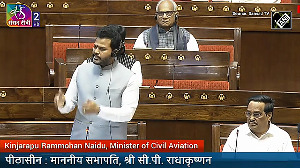Come June 1, the premises that serve as the Andhra Pradesh assembly would have two sittings. In the morning it would serve as the assembly for Seemandhra and in the afternoon, it would act as the Telangana assembly. Aditi Phadnis and Dasarath Reddy report Complicated is an understatement when it comes to politics in divided Andhra Pradesh.
Complicated is an understatement when it comes to politics in divided Andhra Pradesh.
The administrative arrangements for two separate states carved out of one are in place - sort of. Come June 1, the premises that serve as the Andhra Assembly would have two sittings.
In the morning it would serve as the Assembly for Seemandhra and in the afternoon, for Telangana.
"The upper house presents no problem," said an official breezily. "There are two buildings for the Upper House and each new state would have one."
There is no clarity on a host of other issues: The division of spoils, when it comes to the bureaucracy, the local administration, funds, etc. All that would be fine-tuned once the governments are formed.
Little wonder then that hard bargaining is going on for forming the winning alliance -- because all parties know what is at stake.
AP has become even more unpredictable because till 1983 (when N T Rama Rao's Telugu Desam Party emerged), the state saw a mostly unipolar contest. From the 1984 Lok Sabha elections till 2004, the state was witness to -- more or less -- a bipolar contest between the TDP and the Congress.
Now, not only has the state been divided, it will see a multi-polar contest.
The new actors are the Bharatiya Janata Party and the Telangana Rashtra Samithi.
Internally, the BJP and the TDP, which have collaborated in government earlier, have almost decided to go it together in a pre-poll seat adjustment in both, Seemandhra (175 Assembly seats and 25 Lok Sabha seats) and Telangana (117 Assembly seats and 17 Lok Sabha seats).
The seat adjustment should be announced on Monday or Tuesday. The BJP says it is delaying the announcement to narrow the window for rebellion, which would break out inevitably once the alliance is forged.
In Coastal Andhra for instance, there is a dispute over seven or eight seats. But the ones really in contention are two - Visakhapatnam and Vijayawada.
In Visakhapatnam, the BJP's biggest catch was Purandeswari, the daughter of N T Rama Rao, who resigned from a ministership at the Centre and joined the BJP.
If she gets the seat, the TDP, which promised Sreenivasa Rao (a local and a senior Congressman who joined the TDP on the promise that he would be the one to get it), would have to be denied the claim. Together, the BJP and TDP are a formidable combine.
And for the BJP leadership, riding on the Modi brand, it is the first and last chance to build the party in this part of the country.
In Telangana, the situation is a little different. It is no overstatement that Congress president Sonia Gandhi is almost venerated in this region for the sacrifices she made to endorse the division of the state.
While individual Congress MPs are strong in the Telangana region, so is the BJP and so are that of TRS.
In the areas ruled by the erstwhile Nizam of Hyderabad, the Majlis-e-Ittehad-ul-Muslimeen is also a strong force.
In a five-cornered contest, parties are haggling over not just assembly, but also Lok Sabha seats.
In all probability, the Congress would enter into an informal alliance with the TRS, while the BJP might not extend its alliance with the TDP in this party of the state.
April 9 is the last date to file nominations. So, all eyes are fixed on Hyderabad. Andhra Pradesh sent 33 MPs from the Congress to the Lok Sabha in 2009, out of a total of 42.
The party might not reach double digit this time, locals say.











